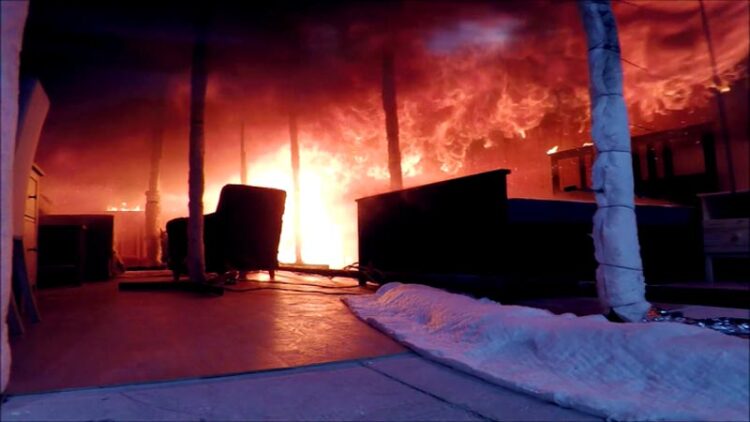AI may come to the rescue of future firefighters

A view from NIST's Burn Observation Bubble (BOB) of a burning structure during an experiment, one minute before flashover.
Credit: NIST
In firefighting, the worst flames are the ones you don’t see coming. Amid the chaos of a burning building, it is difficult to notice the signs of impending flashover — a deadly fire phenomenon wherein nearly all combustible items in a room ignite suddenly. Flashover is one of the leading causes of firefighter deaths, but new research suggests that artificial intelligence (AI) could provide first responders with a much-needed heads-up.
Researchers at the National Institute of Standards and Technology (NIST), the Hong Kong Polytechnic University and other institutions have developed a Flashover Prediction Neural Network (FlashNet) model to forecast the lethal events precious seconds before they erupt. In a new study published in Engineering Applications of Artificial Intelligence, FlashNet boasted an accuracy of up to 92.1% across more than a dozen common residential floorplans in the U.S. and came out on top when going head-to-head with other AI-based flashover predicting programs.
Flashovers tend to suddenly flare up at approximately 600 degrees Celsius (1,100 degrees Fahrenheit) and can then cause temperatures to shoot up further. To anticipate these events, existing research tools either rely on constant streams of temperature data from burning buildings or use machine learning to fill in the missing data in the likely event that heat detectors succumb to high temperatures.
Until now, most machine learning-based prediction tools, including one the authors previously developed, have been trained to operate in a single, familiar environment. In reality, firefighters are not afforded such luxury. As they charge into hostile territory, they may know little to nothing about the floorplan, the location of fire or whether doors are open or closed.
“Our previous model only had to consider four or five rooms in one layout, but when the layout switches and you have 13 or 14 rooms, it can be a nightmare for the model,” said NIST mechanical engineer Wai Cheong Tam, co-first author of the new study. “For real-world application, we believe the key is to move to a generalized model that works for many different buildings.”
To cope with the variability of real fires, the researchers beefed up their approach with graph neural networks (GNN), a kind of machine learning algorithm good at making judgments based on graphs of nodes and lines, representing different data points and their relationships with one another.
“GNNs are frequently used for estimated time of arrival, or ETA, in traffic where you can be analyzing 10 to 50 different roads. It’s very complicated to properly make use of that kind of information simultaneously, so that’s where we got the idea to use GNNs,” said Eugene Yujun Fu, a research assistant professor at the Hong Kong Polytechnic University and study co-first author. “Except for our application, we’re looking at rooms instead of roads and are predicting flashover events instead of ETA in traffic.”
The researchers digitally simulated more than 41,000 fires in 17 kinds of buildings, representing a majority of the U.S. residential building stock. In addition to layout, factors such as the origin of the fire, types of furniture and whether doors and windows were open or closed varied throughout. They provided the GNN model with a set of nearly 25,000 fire cases to use as study material and then 16,000 for fine tuning and final testing.
Across the 17 kinds of homes, the new model’s accuracy depended on the amount of data it had to chew on and the lead time it sought to provide firefighters. However, the model’s accuracy — at best, 92.1% with 30 seconds of lead time — outperformed five other machine-learning-based tools, including the authors’ previous model. Critically, the tool produced the least false negatives, dangerous cases where the models fail to predict an imminent flashover.
The authors threw FlashNet into scenarios where it had no prior information about the specifics of a building and the fire burning inside it, similar to the situation firefighters often find themselves in. Given those constraints, the tool’s performance was quite promising, Tam said. However, the authors still have a ways to go before they can take FlashNet across the finish line. As a next step, they plan to battle-test the model with real-world, rather than simulated, data.
“In order to fully test our model’s performance, we actually need to build and burn our own structures and include some real sensors in them,” Tam said. “At the end of the day, that’s a must if we want to deploy this model in real fire scenarios.”
Journal: Engineering Applications of Artificial Intelligence
DOI: 10.1016/j.engappai.2022.105258
Article Title: A spatial temporal graph neural network model for predicting flashover in arbitrary building floorplans
Media Contact
Jonathan Griffin
National Institute of Standards and Technology (NIST)
jonathan.griffin@nist.gov
Office: 301-975-4117
All latest news from the category: Information Technology
Here you can find a summary of innovations in the fields of information and data processing and up-to-date developments on IT equipment and hardware.
This area covers topics such as IT services, IT architectures, IT management and telecommunications.
Newest articles

Silicon Carbide Innovation Alliance to drive industrial-scale semiconductor work
Known for its ability to withstand extreme environments and high voltages, silicon carbide (SiC) is a semiconducting material made up of silicon and carbon atoms arranged into crystals that is…

New SPECT/CT technique shows impressive biomarker identification
…offers increased access for prostate cancer patients. A novel SPECT/CT acquisition method can accurately detect radiopharmaceutical biodistribution in a convenient manner for prostate cancer patients, opening the door for more…

How 3D printers can give robots a soft touch
Soft skin coverings and touch sensors have emerged as a promising feature for robots that are both safer and more intuitive for human interaction, but they are expensive and difficult…





















